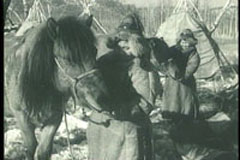The Oroqen
鄂倫春族

Oroqen means “people of the mountain.” China’s 6,000 Oroqen inhabit the Oroqen Autonomous Banner in the Greater and Lesser Hinggan Mountains of Inner Mongolia. Some live in Heilongjiang Province. Historically, the Oroqen were a nomadic people. The Oroqen love to dance and sing and have a repertoire of folk songs praising nature, love, hunting and the struggles of life. They practice shamanism and worship certain animals, particularly the bear and tiger. All things on earth have their own spirits, they believe, and a relationship between the Oroqens and animals exists. This has given rise to totemism. This documentary film records the particular customs of the Oroqen customs and their nomadiac hunting lives through a four-season migration.
Directors
Yang Kuang-Hai
Yang (b. November 12, 1932). A member of the Bai minority and steeped in Han culture, joined China's military academy in 1950. Yang was assigned to work as a photographer in the Ba-Yi Film Studio and later in 1960 to the Beijing Scientific and Educational Film Studio as a director and cameraman.
“The Oroqen” records the primitive hunting way of life of the Oroqen people, revealing the process of social change from a hunter-gatherer society to that of an agricultural community. He has made over thirty films on different minorities, including the Naxi, the Dai, and the Miao.
